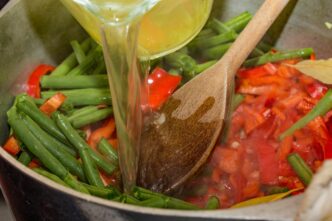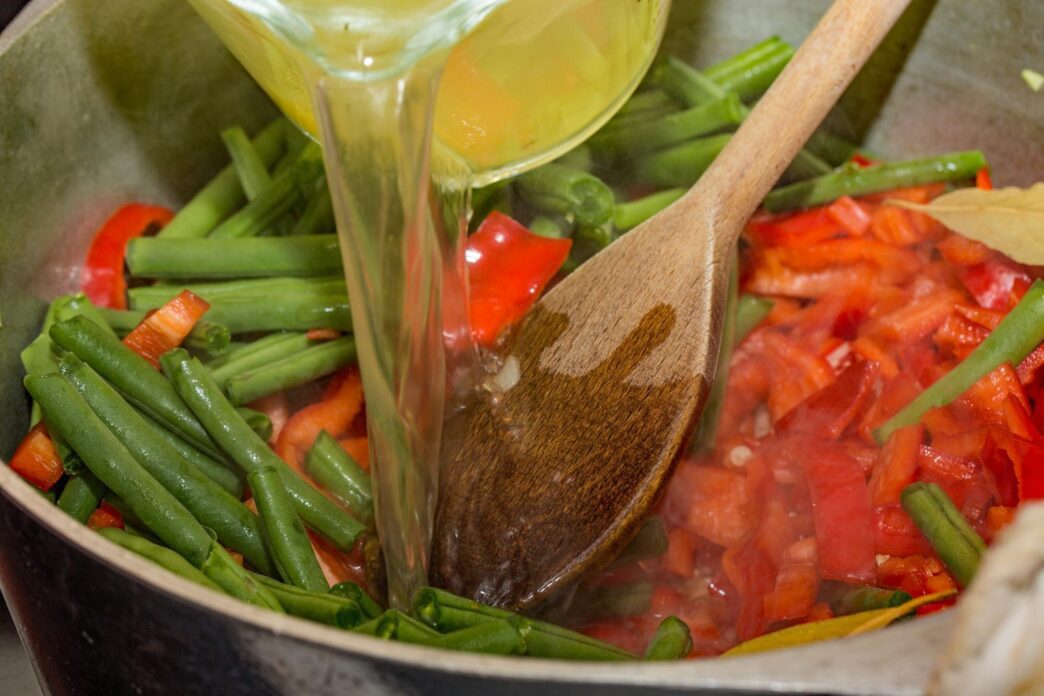A Quick Takeaway
The Story Behind the Trend
How to Make It Work for You
The Community View
Homemade vegetable stock is a simple, cost-effective way for anyone to significantly enhance the flavor and nutritional value of their meals while reducing food waste. By utilizing kitchen scraps and fresh produce, you can create a versatile, nutrient-dense base that boosts immunity, supports digestion, and offers a clean foundation for countless dishes, making it a cornerstone for healthier cooking every day. This foundational ingredient is easy to master and can transform your culinary approach, moving you towards a more wholesome and sustainable lifestyle.
The Power of Homemade: Why Stock Matters for Your Health
Unlike many store-bought varieties that can be laden with excessive sodium, artificial flavors, and preservatives, homemade vegetable stock provides a pure, clean base for your cooking. It allows you complete control over ingredients, ensuring you’re adding only beneficial components to your diet. This control is paramount for individuals managing blood pressure, seeking to reduce processed food intake, or those with specific dietary sensitivities.
Beyond its purity, homemade stock is a nutritional powerhouse. As vegetables simmer slowly, their vitamins, minerals, and antioxidants are gently released into the liquid, creating a rich elixir. This nutrient-rich fluid supports hydration, provides essential electrolytes, and contributes to overall vitality. It’s a gentle way to nourish your body from the inside out, supporting everything from immune function to healthy digestion.
Building Your Base: What Goes into Great Vegetable Stock
The beauty of vegetable stock lies in its flexibility and the opportunity to use up ingredients that might otherwise go to waste. A classic stock begins with an aromatic trio: onions, carrots, and celery, often referred to as mirepoix. These provide a sweet, savory foundation that is essential for depth of flavor.
Essential Ingredients for Flavor and Nutrition
-
Aromatics: In addition to the mirepoix, consider leeks, garlic cloves (smashed or peeled), and even shallots for layers of savory goodness.
-
Hearty Vegetables: Parsnips, mushroom stems, and even the outer layers of cabbage (avoiding the strong inner leaves) can add umami and body without overpowering the stock.
-
Herbs and Spices: Bay leaves, whole black peppercorns, fresh parsley stems, and sprigs of thyme are classic additions that infuse the stock with aromatic complexity. A pinch of dried oregano or rosemary can also be lovely.
-
Unexpected Boosters: A tablespoon of tomato paste, lightly caramelized, can add a beautiful reddish hue and a touch of sweetness. Dried mushrooms, especially porcini, can impart a deep, earthy umami that elevates the stock significantly.
Ingredients to Use Sparingly or Avoid
While versatility is key, some vegetables are best avoided or used in very small quantities when making stock. Cruciferous vegetables like broccoli, cauliflower, and Brussels sprouts can impart a bitter, sulfurous flavor. Starchy vegetables such as potatoes can make the stock cloudy and release too much starch. Beets can turn your stock a vibrant, but often undesirable, purple hue.
Always ensure any kitchen scraps you use are clean and free of mold or spoilage. Onion skins are fine for color, but excessive amounts can make the stock bitter. Stick to the cleaner, fresher ends and peels for the best results.
The Art of Simmering: Crafting Your Stock Step-by-Step
Making vegetable stock is more an art of patience than precision, but a few key steps will ensure a flavorful and clear result.
Preparation is Key
Start by washing and roughly chopping all your vegetables and scraps. There’s no need for fine dicing, as everything will be strained out later. For an even deeper flavor, consider sautéing your mirepoix and other aromatics in a tablespoon of olive oil in your stock pot for about 5-10 minutes until softened and slightly caramelized. This step adds a wonderful layer of complexity.
The Gentle Simmer
Place all your prepared vegetables, herbs, and spices into a large stockpot. Cover them generously with cold water – using cold water helps to slowly extract flavors and nutrients, resulting in a clearer, more flavorful stock. Bring the mixture to a boil, then immediately reduce the heat to a gentle simmer. Cover the pot partially to allow some steam to escape while preventing too much evaporation.
Allow the stock to simmer for at least 1 to 2 hours, or up to 4 hours for a richer, more concentrated flavor. Resist the urge to stir frequently, as this can agitate the vegetables and lead to a cloudy stock. Skim off any foam that rises to the surface during the first 30 minutes of simmering.
Straining and Cooling
Once the simmering is complete, carefully strain the stock through a fine-mesh sieve into a clean bowl or container. You can gently press the solids with the back of a spoon to extract any remaining liquid, but avoid mashing them vigorously, as this can release bitter flavors and starch. Discard the spent vegetables, as most of their flavor and nutrients have now been transferred to the liquid.
Allow the stock to cool completely before storing it. Rapid cooling is important for food safety. You can place the pot in an ice bath or divide the stock into smaller containers to cool faster. Once cool, transfer it to airtight containers.
Smart Storage Solutions
Homemade vegetable stock can be refrigerated for up to 5-7 days. For longer storage, it freezes beautifully. Pour cooled stock into freezer-safe containers, zip-top bags (laid flat), or even ice cube trays for convenient single portions. Frozen stock can last for up to 6 months without significant loss of quality.
Unleash Flavor: Cooking with Your Homemade Stock
The versatility of homemade vegetable stock is one of its greatest assets. It serves as a fantastic foundation for a myriad of dishes, elevating their flavor profile and nutritional content.
Use it as the liquid base for hearty soups and stews, providing depth that water simply cannot. Cook grains like quinoa, rice, or couscous in stock instead of water for an instant flavor upgrade. It’s also excellent for braising vegetables, tofu, or tempeh, infusing them with savory notes. Whisk it into sauces and gravies, or use it to sauté vegetables for an extra layer of richness.
Your Culinary Foundation
Mastering homemade vegetable stock is a simple yet profoundly impactful step towards a healthier, more flavorful kitchen. It empowers you to control your ingredients, reduce waste, and infuse every meal with a wholesome, nutrient-rich base. Embrace this fundamental skill, and watch as your cooking transforms into a truly nourishing and delicious experience.








